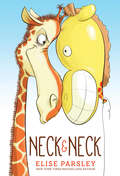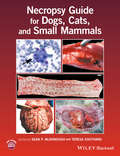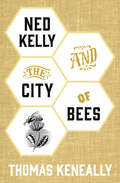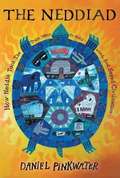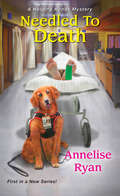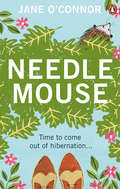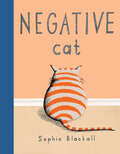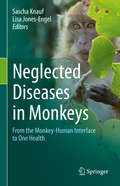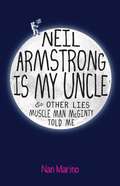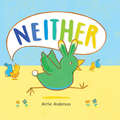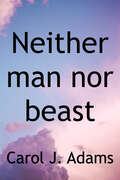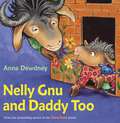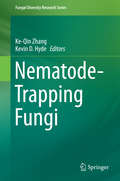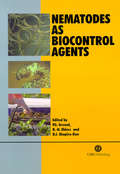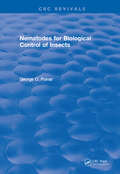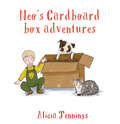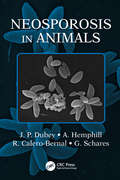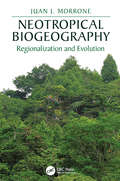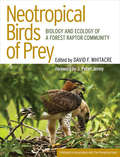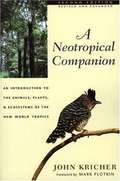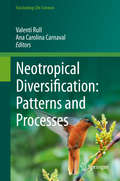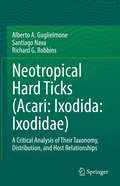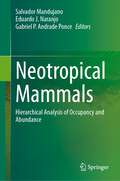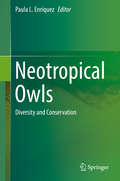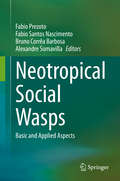- Table View
- List View
Neck & Neck
by Elise ParsleyIn this crowd-pleasing read-aloud from the creator of the bestselling If You Ever Want to Bring an Alligator to School, Don't!, a giraffe's self-esteem is tested during a hilarious confrontation between unlikely look-alikes!Everybody loves Leopold the giraffe. He inspires awe and wonder. His adoring fans gaze and cheer. Best of all, they feed him lots of deeeelicious snacks! But, one day, a shiny, bobble-headed new rival comes in and ruins everything...a giraffe-shaped balloon! Just how far will Leopold go to prove that he's the hero of the zoo? Readers learn that actions speak far louder than looks in this laugh-out-loud face-off from Elise Parsley--the New York Times bestselling creator of the Magnolia Says DON'T! series.
Necropsy Guide for Dogs, Cats, and Small Mammals
by Sean P. Mcdonough Teresa SouthardNecropsy Guide for Dogs, Cats, and Small Mammals is a complete, practical resource for performing necropsies on dogs, cats, rabbits, rodents, and ferrets in the veterinary clinic, animal shelter, research laboratory, or in the field. Provides practical guidance on all aspects of performing an necropsy on dogs, cats, and small mammals and interpreting the results Presents more than 200 full-color images to demonstrate techniques and findings Offers step-by-step instructions for the necropsy process and collecting samples Includes an anatomy review, discussion of dissection techniques, and list of common artifacts and post-mortem changes for each organ system Supports veterinarians in performing a necropsy in any setting, including animal shelters, veterinary clinics, research laboratories, and in the field
Ned Kelly and the City of Bees
by Thomas KeneallyNed Kelly would never have imagined shrinking his size in order to escape the dreary hospital bed where he’s recovering from appendicitis. But, that’s exactly what Apis, his new friend (who happens to be a bee), helps him do with the aid of a special gold liquid. At apian size, Ned flies off with Apis and Nancy Clancy (who speaks only in rhyme) to try life in the hive. Although he questions some of their practices, like disposing of old drones who can’t work anymore, Ned soon makes friends with the bees, including Romeo, a drone lovesick for the Queen, Basil, a drone-rights activist, and even the haughty Queen herself.
The Neddiad: How Neddie Took the Train, Went to Hollywood, and Saved Civilization
by Daniel PinkwaterWhen shoelace heir Neddie Wentworthstein and his family take the train from Chicago to Los Angeles in the 1940s, he winds up in possession of a valuable Indian turtle artifact whose owner is supposed to be able to prevent the impending destruction of the world, but he is not sure exactly how.
Needled to Death (A Helping Hands Mystery #1)
by Annelise RyanAs a colleague of deputy coroner Mattie Winston, social worker Clothilde &“Hildy&” Schneider is no stranger to unsolved murders at Sorenson General Hospital. Except this time, it&’s up to her to crack the case . . . Motivated by her own difficult past, Hildy has an unparalleled commitment to supporting troubled clients through grief and addiction in Sorenson, Wisconsin. But when a distraught group therapy member reveals disturbing details about her late son&’s potential murder, Hildy goes from dedicated mental health professional to in-over-her-head amateur sleuth . . . Alongside her loyal therapy Golden Retriever, Hildy stumbles through incriminating clues—and an unlikely partnership with Detective Bob Richmond, the irresistibly headstrong cop who shares her passion for helping others. With signs of foul play surfacing all over town, can Hildy and Detective Richmond pinpoint the deadly traits of a sharp-witted killer before another seat gets filled at grief therapy? Praise for Annelise Ryan and her Mattie Winston series &“The funniest deputy coroner to cut up a corpse since, well, ever!&” —Laura Levine, author of Killer Cruise &“The forensic details will interest Patricia Cornwell readers . . . while the often slapstick humor and the blossoming romance between Mattie and Hurley will draw Evanovich fans.&” —Booklist
Needlemouse: The uplifting bestseller featuring the most unlikely heroine of 2019
by Jane O'ConnorTime to come out of hibernation...Sylvia Penton has been hibernating for years, it's no wonder she's a little prickly...Sylvia lives alone, dedicating herself to her job at the local university. On weekends, she helps out at a local hedgehog sanctuary because it gives her something to talk about on Mondays - and it makes people think she's nicer than she is.Only Sylvia has a secret: she's been in love with her boss, Professor Lomax, for over a decade now, and she's sure he's just waiting for the right time to leave his wife. Meanwhile she stores every crumb of his affection and covertly makes trouble for anyone she feels gets in his way.But when a bright new PhD candidate catches the Professor’s eye, Sylvia’s dreams of the fairy tale ending she has craved for so long, are soon in tatters, driving her to increasingly desperate measures and an uncertain future. Sylvia might have been sleep walking through her life but things are about to change now she’s woken up…A quirky, charming uplifting novel perfect for fans of Gail Honeyman's Eleanor Oliphant is Completely Fine and Sarah Haywood's The Cactus. The feelgood bestseller about unrequited love, loneliness and the redemptive qualities of hedgehogs featuring the most unlikely heroine of 2019.________________________________WHAT READERS ARE SAYING'An eccentrically heartwarming tale of steeping out of your comfort zone. I was rooting for Sylvia' - Lottie, Netgalley'I was charmed by this tale. A feel-good book' - Heather, Netgalley'A lovely story with delightful characters. Would highly recommend, especially if you are a fan of Ruth Hogan and Gail Honeyman' - Mary, Netgalley'An absolutely superb novel about someone who is dissatisfied with her life but feels it's difficult to change. I would highly recommend to anyone who likes a quirky novel to entertain them' - Sue, Netgalley'Oh how I adored this book which is reminiscent of Eleanor Oliphant is Completely Fine' - Justine, Netgalley'I like a book that makes me feel uplifted, that soothes the soul, and this book certainly did that. Sylvia is definitely one of my favourite fictional characters' - Joanne, Netgalley
Negative Cat
by Sophie BlackallTwo-time Caldecott winner Sophie Blackall spins a winning tale about Max, a feline whose behavior doesn't win any raves, except from the boy who believes in him and finds a way to turn a negative into a positive.When a boy is FINALLY allowed to get a cat, he has no doubts about which one to bring home from the shelter. But Max the cat isn&’t quite what the family expected. He shuns the toy mouse, couldn&’t care less about the hand-knitted sweater, and spends most of his time facing the wall. One by one, the family gives up on Max, but the boy loves his negative cat so much, he&’ll do anything to keep him. Even the thing he dreads most: practicing his reading. Which, as it turns out, makes everything positive!
Neglected Diseases in Monkeys: From the Monkey-Human Interface to One Health
by Sascha Knauf Lisa Jones-EngelThis book offers a valuable resource, reviewing the current state of knowledge concerning the pathology and epidemiology of infectious diseases in both captive and wild monkeys. The One Health concept forms the framework of all chapters. The multidisciplinary team of authors addresses neglected diseases caused by the three major pathogen groups - bacteria, viruses, and parasites. Moreover, the volume discusses key virulence factors such as the evolution of antibiotic resistance, and the ecological drivers of and human influence on pathogen transmission. Demonstrating how researchers working on monkeys diseases are increasingly thinking outside the box, this volume is an essential reference guide to the field of One Health and will serve as an asset for stakeholders in conservation, healthcare and research organizations that face the challenge of moving beyond classical human oriented approaches to health.
Neil Armstrong Is My Uncle and Other Lies Muscle Man McGinty Told Me
by Nan MarinoIn the entire town of Massapequa Park, only I can see Muscle Man McGinty for what he really is. <P><P>A phony. <P>It's the summer of 1969, and things are not only changing in Tamara's little Long Island town, but in the world. <P>Perhaps Tamara could stand to take one small step toward a bit of compassion and understanding? <P><P> A terrific debut novel with truly vivid characters and a wonderful voice.
Neither
by Airlie Andersonp.p1 {margin: 0.0px 0.0px 0.0px 0.0px; font: 13.0px Times} In this colorful and touching story that celebrates what makes each of us unique, a little creature that's not quite a bird and not quite a bunny--it's "neither"--searches for a place to fit in. In the Land of This and That, there are only two kinds: blue bunnies and yellow birds. But one day a funny green egg hatches, and a little creature that's not quite a bird and not quite a bunny pops out. It's neither! Neither tries hard to fit in, but its bird legs aren't good for jumping like the other bunnies, and its fluffy tail isn't good for flapping like the other birds. It sets out to find a new home and discovers a very different place, one with endless colors and shapes and creatures of all kinds. But when a blue bunny and a yellow bird with some hidden differences of their own arrive, it's up to Neither to decide if they are welcome in the Land of All. This colorful, simple, and touching story promotes diversity and offers a valuable lesson to the youngest of audiences: it is our differences that unite us.
Neither Man Nor Beast: Feminism and the Defense of Animals
by Carol J. AdamsThis book explores the common link between cultural attitudes to women and animals in modern Western culture that have enabled the systematic exploitation of both. A vivid work that takes in environmental ethics, theological perspectives and feminist theory, the Bloomsbury Revelations edition.
Nelly Gnu and Daddy Too
by Anna DewdneyDrawing. Reading.Building.Painting. These are things Nelly loves to do…but they&’re always better with Daddy Gnu! With fun-to-read rhyme, a little silliness, and a lot of warmth, Anna Dewdney—the creator of the beloved llama llama books—tells the story of a daughter and her daddy and their wonderful day together.
Nematode-Trapping Fungi
by Ke-Qin Zhang Kevin D. HydeThese chapters provide up-to-date information on nematophagous fungi, particularly those of the Orbiliaceae in Ascomycota, whose asexual states produce nematode-trapping devices. The authors consider fungal-nematode interactions, fossil fungi, the biodiversity, ecology and geographical distribution of nematode-trapping fungi, and their potential use in biocontrol of nematodes, all in detail. Nematode-trapping fungi with adhesive or mechanical hyphal traps are the main focus of this book which begins with an overview of the data on nematode-trapping fungi, including their taxonomy, phylogeny and evolution. Subsequent chapters expand upon the methods and techniques used to study these fascinating fungi. Keys for genera of Arthrobotrys, Drechslerella and Dactylellina, which include all reported species of predatory orbiliaceous fungi are presented and numerous species from these genera are morphologically described and illustrated. The ecology of nematode-trapping fungi is expertly presented: their occurrence and habitats, their geographical and seasonal distribution and the effects of soil conditions and nematode density on their distribution all feature amongst the relevant themes. Further chapters examine the use of nematode-trapping fungi in biological control and the authors consider nematicidal activities in detail, exploring the many compounds from fungi that feature in nematicidal activities and of course useful paths for further study on this topic. This is a highly informative and carefully presented book, providing scientific insight for scholars with an interest in fungi and in biological control of nematodes.
Nematodes as Biocontrol Agents
by Parwinder S. Grewal Ralf-Udo Ehlers David I. Shapiro-IlanThis book aims to document and illustrate the major developments in the use of nematodes for biological control of insects and slugs. It has three major sections covering entomopathogenic nematodes, entomophilic nematodes, and slug-parasitic nematodes. Each of these sections discusses biology, commercial production, formulation and quality control, application technology, strategy and safety.
Nematodes for Biological Control of Insects
by George O. PoinarThis book discusses nematodes for biological of insects. The book includes the following chapters; classification of nematode, key to entomogenous nematodes, nematode groups, microorganisms associated with entomogenous nematodes, immunity to entomogenous nematodes, natural enemies of entomogenous nematodes, environmental impact of entomogenous nematodes, and future prospects.
Neo's Cardboard Box Adventures
by Alicia JenningsWhen a little boy gets dropped off at his grandparents house he finds an empty cardboard box. With his friends, a dog and a cat, what imaginative adventures will they have in it? Where will they go? How far could you travel without leaving your home?
Neosporosis in Animals
by J.P. Dubey A. Hemphill R. Calero-Bernal Gereon ScharesKey features: Written by the scientist who named this parasite and was the first to set up proper diagnostic techniques Serves as the first ever book to provide information on the parasite structure, biology, pathogenesis, clinical signs, epidemiology, prevention, and control of neosporosis Covers both approaches toward preventing & controlling this disease: Developing an efficacious vaccine and sound cattle management practices Contains a wealth of illustrations, including many of the author's original photographs of the parasite Provides basic information on immunologic and molecular aspects of the disease Abortion is a worldwide problem in the livestock industry accounting for annual economic losses of billions of dollars, and N. caninum is a major cause of it. Neosporosis is a newly recognized disease of animals. Until 1988 it was misdiagnosed as toxoplasmosis. Considerable progress in understanding the biology of neosporosis has been made in the last 30 years, resulting in more than 2,000 scientific publications. The economic importance of abortion in cattle, and the availability of knowledge, reagents, and technology used to study toxoplasmosis, have contributed to the rapid progress in understanding the biology of neosporosis. Written by pioneers in this field, Neosporosis in Animals presents a comprehensive summary of the biology of neosporosis, starting with chapter 1 on the historical background of the discovery of the disease. Subsequent chapters deal with general aspects of the biology of N. caninum (chapter 2), techniques (chapter 3), and the disease caused by this parasite in cattle (chapter 4), dogs (chapter 5), and all other animals including sheep, pigs, primates and humans (chapters 6-18). This book provides, for the first time in a single authoritative source, a complete account of the structure, biology, clinical disease, diagnosis, epidemiology, treatment, attempts at immunoprophylaxis, and control in all hosts. There are 175 illustrations and tables devoted to the life cycle, structure of parasitic stages, and lesions. More than 2100 references are cited, allowing the reader to locate additional information on specific topics in an efficient way. This book will be useful to a broad range of researchers in biology and veterinarians.
Neotropical Biogeography: Regionalization and Evolution (CRC Biogeography Series)
by Juan J. MorroneNeotropical Biogeography: Regionalization and Evolution presents the most comprehensive single-source treatment of the Neotropical region derived from evolutionary biogeographic studies. The book provides a biogeographic regionalization based on distributional patterns of plant and animal taxa, discusses biotic relationships drawn from track and cladistic biogeographic analyses, and identifies cenocrons (subsets of taxa within biotas identified by their common origin and evolutionary history). It includes maps, area cladograms and vegetation profiles. <P><P> The aim of this reference is to provide a biogeographic regionalization that can be used by graduate students, researchers and other professionals concerned with understanding and describing distributional patterns of plants and animals in the Neotropical region. It covers the 53 biogeographic provinces of the Neotropical region that are classified into the Antillean, Brazilian and Chacoan subregions, and the Mexican and South American transition zones.
Neotropical Birds of Prey: Biology and Ecology of a Forest Raptor Community
by J. Peter Jenny David F WhitacreUntil recently, surprisingly little has been known about the biology and behavior of tropical forest raptors, including such basic aspects as diets, breeding biology, habitat requirements, and population ecology, information critical to the development of conservation efforts. The Peregrine Fund conducted a significant eight-year-long research program on the raptor species, including owls, in Tikal National Park in Guatemala to learn more about Neotropical birds of prey. Impressive and unprecedented in scale, this pioneering research also involved the development of new methods for detecting, enumerating, and studying these magnificent but often elusive birds in their forest home. Beautifully illustrated with photographs of previously little-known species, the resulting book is the most important single source for information on the lowland tropical forest raptor species found in Central America.Neotropical Birds of Prey covers twenty specific species in depth, including the Ornate Hawk-Eagle, the Barred Forest-Falcon, the Bat Falcon, and the Mexican Wood Owl, offering thorough synopses of all current knowledge regarding breeding biology and behavior, diet, habitat use, and spatial needs. Contributors to this landmark work also show how the populations fit together as a community with overlapping habitat and prey needs that can put them in competition with reptiles and mammalian carnivores as well, yet differ from one another in their nesting or feeding behaviors and population dynamics. The work's substantive original data offer interesting comparisons between tropical and temperate zone species, and provide a basis for establishing conservation measures based on firsthand research. Making available for the first time new data on the biology, ecology, behavior, and conservation of the majestic owls and raptors of the New World tropics, this book will appeal to a wide ornithological readership, especially the many raptor enthusiasts around the world.
A Neotropical Companion: An Introduction to the Animals, Plants, and Ecosystems of the New World Tropics (2nd Edition, Revised and Expanded)
by John KricherA Neotropical Companion is an extraordinarily readable introduction to the American tropics, the lands of Central and South America, their remarkable rainforests and other ecosystems, and the creatures that live there. It is the most comprehensive one-volume guide to the Neotropics available today. Widely praised in its first edition, it remains a book of unparalleled value to tourists, students, and scientists alike. This second edition has been substantially revised and expanded to incorporate the abundance of new scientific information that has been produced since it was first published in 1989. Major additions have been made to every chapter, and new chapters have been added on Neotropical ecosystems, human ecology, and the effects of deforestation. Biodiversity and its preservation are discussed throughout the book, and Neotropical evolution is described in detail. This new edition offers all new drawings and photographs, many of them in color. As enthusiastic readers of the first edition will attest, this is a charming book. Wearing his learning lightly and writing with ease and humor, John Kricher presents the complexities of tropical ecology as accessible and nonintimidating. Kricher is so thoroughly knowledgeable and the book is so complete in its coverage that general readers and ecotourists will not need any other book to help them identify and understand the plants and animals, from birds to bugs, that they will encounter in their travels to the New World tropics. At the same time, it will fascinate armchair travelers and students who may get no closer to the Neotropics than this engagingly written book.
Neotropical Diversification: Patterns and Processes (Fascinating Life Sciences)
by Valentí Rull Ana Carolina CarnavalThis book provides a comprehensive overview of the patterns of biodiversity in various neotropical ecosystems, as well as a discussion on their historical biogeographies and underlying diversification processes. All chapters were written by prominent researchers in the fields of tropical biology, molecular ecology, climatology, paleoecology, and geography, producing an outstanding collection of essays, synthetic analyses, and novel investigations that describe and improve our understanding of the biodiversity of this unique region. With chapters on the Amazon and Caribbean forests, the Atlantic rainforests, the Andes, the Cerrado savannahs, the Caatinga drylands, the Chaco, and Mesoamerica – along with broad taxonomic coverage – this book summarizes a wide range of hypotheses, views, and methods concerning the processes and mechanisms of neotropical diversification. The range of perspectives presented makes the book a truly comprehensive, state-of-the-art publication on the topic, which will fascinate both scientists and general readers alike.
Neotropical Hard Ticks (Acari (Acari (Acari (Acari: Ixodida: Ixodidae): A Critical Analysis of Their Taxonomy, Distribution, and Host Relationships
by Alberto A. Guglielmone Santiago Nava Richard G. RobbinsOf the 758 species of hard ticks (family Ixodidae) currently known to science, 137 (18%) are found in the Neotropical Zoogeographic Region, an area that extends from the eastern and western flanks of the Mexican Plateau southward to southern Argentina and Chile and that also includes the Greater and Lesser Antilles and the Galápagos Islands. This vast and biotically rich region has long attracted natural scientists, with the result that the literature on Neotropical ticks, which are second only to mosquitoes as vectors of human disease and are of paramount veterinary importance, is enormous, diffuse, and often inaccessible to non-specialists. In this book, three leading authorities on the Ixodidae have combined their talents to produce a summary of essential information for every Neotropical tick species. Under each species name, readers will find an account of the original taxonomic description and subsequent redescriptions, followed by an overview of its geographic distribution and host relationships, including a discussion of human parasitism. Additional sections provide detailed analyses of tick distribution by country and zoogeographic subregion (the Caribbean, southern Mexico and Central America, South America, and the Galápagos Islands), together with a review of the phenomenon of invasive tick species and examination of the many valid and invalid names that have appeared in the Neotropical tick literature. The text concludes with an unprecedented tabulation of all known hosts of Neotropical Ixodidae, including the tick life history stages collected from each host. This book is an invaluable reference for biologists and biomedical personnel seeking to familiarize themselves with the Neotropical tick fauna.
Neotropical Mammals: Hierarchical Analysis of Occupancy and Abundance
by Salvador Mandujano Eduardo J. Naranjo Gabriel P. Andrade PonceThis book reviews and synthesizes studies on local and regional occupancy and abundance of Neotropical mammals from central Mexico to South America. The book focuses primarily on addressing issues of a wide array of mammalian species from a population level in different habitats and ecosystems across the Neotropical region. Occupancy and abundance analyzed through hierarchical approaches with a variety of statistical tools are the central ecological parameters treated in the chapters of this volume. This book will be an updated reference for researchers, professionals, students, wildlife managers, and people interested in mammal ecology and conservation in tropical and subtropical regions.
Neotropical Owls
by Paula L. EnriquezThis book presents a comprehensive biological and ecological information about owls in the neotropic area. In addition the book covers topics such as threats and conservation strategies for these nocturnal birds of prey from 18 Neotropical countries. Owls are a good example of diversification processes and have developed evolutionary characteristics themselves. These species are found almost everywhere in the world but most of them are distributed in tropical areas and about a third of them live in the Neotropics. This biogeographic region has a high biodiversity and even share lineages of species from other continents because at some point all were part of Pangea. Although we still have much to know and understand about this diverse, scarcely studied and threatened group this work aims to be a precedent for future and further research on the subject.
Neotropical Social Wasps: Basic and applied aspects
by Fabio Prezoto Fabio Santos Nascimento Bruno Corrêa Barbosa Alexandre SomavillaThis book provides updated information on this intriguing and exciting group of insects: Neotropical Social Wasps. These insects have a particular biology and their colonies are formed by a few cooperative females living in either small or massive, structured nests where stinging individuals organize their activities and defend their offspring. Topics include evolutionary aspects, biogeography, post-embryonic development, community behavior and ecology, economic importance, and research methods.
